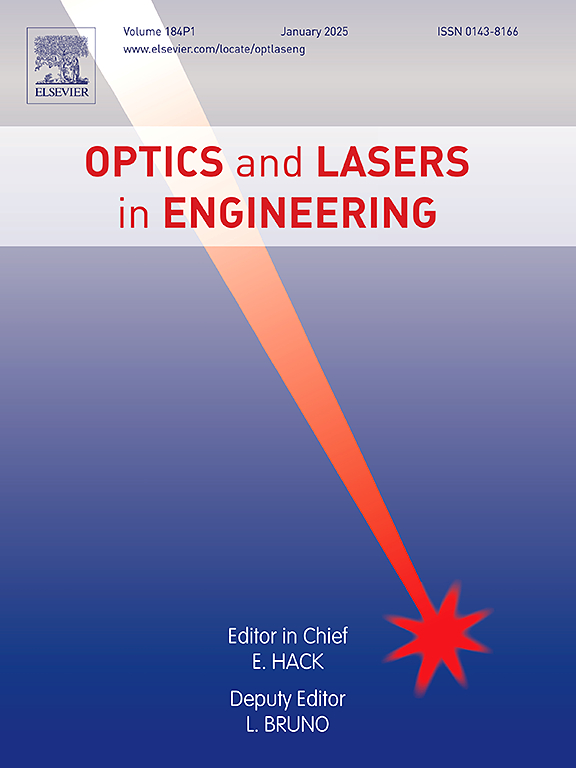Effects of heat transfer characteristics of atmospheric horizontal buoyant jets on optical aberrations in a laser system
IF 3.7
2区 工程技术
Q2 OPTICS
引用次数: 0
Abstract
An effective thermal monitoring and management strategy is required to ensure stable performance of an optical system. Although forced convection cooling systems help to maintain the temperature within an appropriate range, such systems always exhibit temperature gradients and turbulence. The resulting thermal lensing effects degrade optical performance. An understanding of the convective heat transfer characteristics and thermal lensing effects is essential for optimizing optical system performance. This study analyzes the independent thermo-optical effects of convective heat transfer by a horizontal buoyant jet. The results showed that the buoyancy of the jet induced an increase in the core flow. Rays passing through the flow exhibited various aberrations including a negative Y-tilt, positive defocus, and negative vertical astigmatism. These effects intensified as the discharge temperature increased. Turbulent dissipation rate analysis revealed that the variability of these aberrations was attributable to fluctuations in the thermodynamic parameters of air. The variability increased at turbulent dissipation rates. Based on the theoretical background of thermo-optical phenomena in air, the effect of convective heat transfer on these aberrations was explored via numerical simulations and experimentally validated using a Shack–Hartmann wavefront sensor. These findings indicate that quantitative aberration-based analytical methods aid optical quality evaluation in terms of the thermal management of optical systems.
大气水平浮力射流传热特性对激光系统光学像差的影响
为了保证光学系统的稳定性能,需要一种有效的热监测和管理策略。虽然强制对流冷却系统有助于将温度保持在适当的范围内,但这种系统总是表现出温度梯度和湍流。由此产生的热透镜效应降低了光学性能。了解对流换热特性和热透镜效应对优化光学系统性能至关重要。本文分析了水平浮力射流对流换热的独立热光学效应。结果表明,射流的浮力诱导了芯流的增加。通过光束流的光线表现出各种像差,包括负y轴倾斜、正离焦和负垂直像散。这些影响随着放电温度的升高而增强。湍流耗散率分析表明,这些像差的变化可归因于空气热力学参数的波动。在湍流耗散速率下,变异性增大。基于空气中热光学现象的理论背景,通过数值模拟和Shack-Hartmann波前传感器实验验证了对流换热对这些像差的影响。这些发现表明,基于定量像差的分析方法有助于光学系统热管理方面的光学质量评估。
本文章由计算机程序翻译,如有差异,请以英文原文为准。
求助全文
约1分钟内获得全文
求助全文
来源期刊

Optics and Lasers in Engineering
工程技术-光学
CiteScore
8.90
自引率
8.70%
发文量
384
审稿时长
42 days
期刊介绍:
Optics and Lasers in Engineering aims at providing an international forum for the interchange of information on the development of optical techniques and laser technology in engineering. Emphasis is placed on contributions targeted at the practical use of methods and devices, the development and enhancement of solutions and new theoretical concepts for experimental methods.
Optics and Lasers in Engineering reflects the main areas in which optical methods are being used and developed for an engineering environment. Manuscripts should offer clear evidence of novelty and significance. Papers focusing on parameter optimization or computational issues are not suitable. Similarly, papers focussed on an application rather than the optical method fall outside the journal''s scope. The scope of the journal is defined to include the following:
-Optical Metrology-
Optical Methods for 3D visualization and virtual engineering-
Optical Techniques for Microsystems-
Imaging, Microscopy and Adaptive Optics-
Computational Imaging-
Laser methods in manufacturing-
Integrated optical and photonic sensors-
Optics and Photonics in Life Science-
Hyperspectral and spectroscopic methods-
Infrared and Terahertz techniques
 求助内容:
求助内容: 应助结果提醒方式:
应助结果提醒方式:


